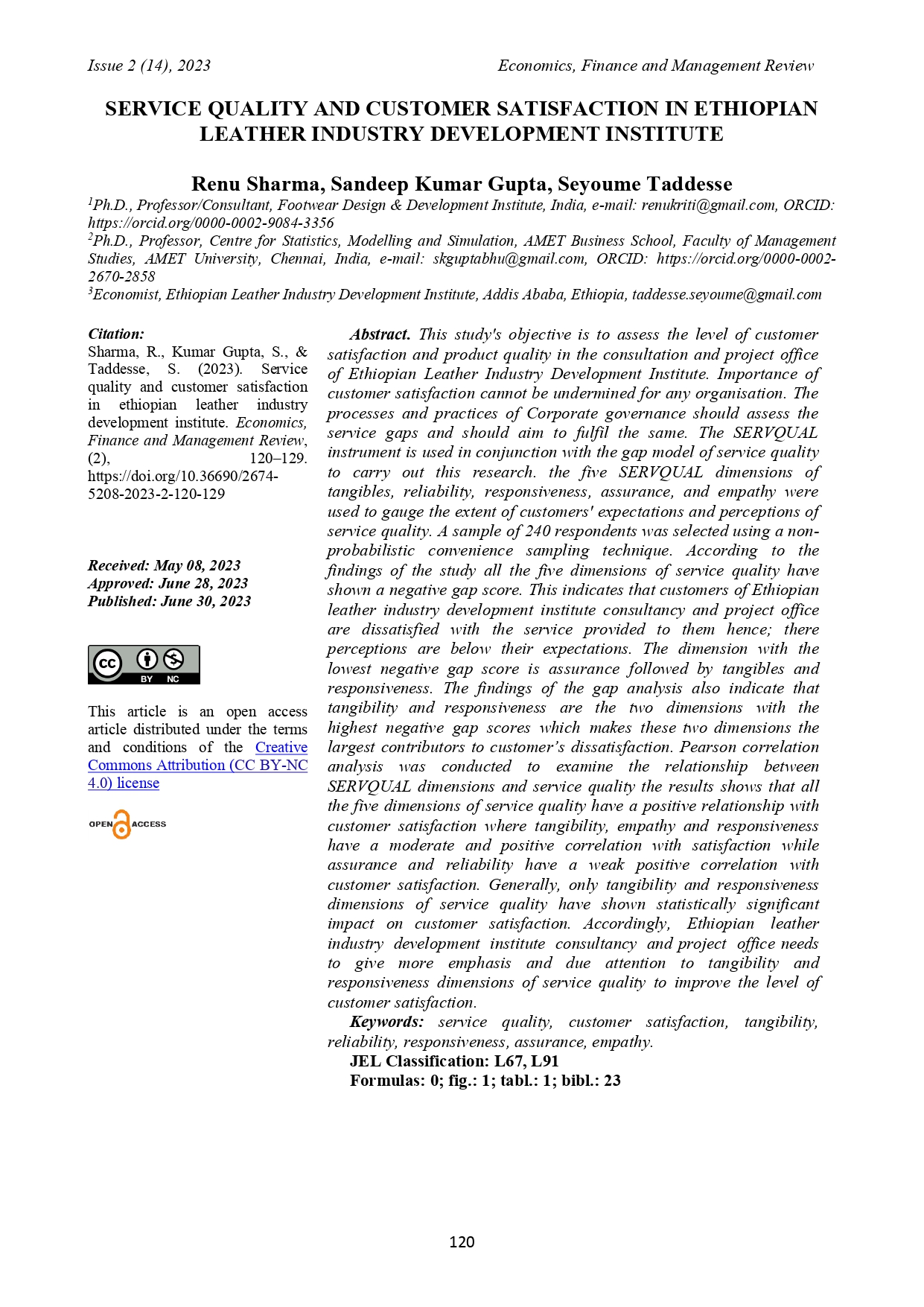SERVICE QUALITY AND CUSTOMER SATISFACTION IN ETHIOPIAN LEATHER INDUSTRY DEVELOPMENT INSTITUTE
DOI:
https://doi.org/10.36690/2674-5208-2023-2-120-129Keywords:
service quality, customer satisfaction, tangibility, reliability, responsiveness, assurance, empathyAbstract
This study's objective is to assess the level of customer satisfaction and product quality in the consultation and project office of Ethiopian Leather Industry Development Institute. Importance of customer satisfaction cannot be undermined for any organisation. The processes and practices of Corporate governance should assess the service gaps and should aim to fulfil the same. The SERVQUAL instrument is used in conjunction with the gap model of service quality to carry out this research. the five SERVQUAL dimensions of tangibles, reliability, responsiveness, assurance, and empathy were used to gauge the extent of customers' expectations and perceptions of service quality. A sample of 240 respondents was selected using a non-probabilistic convenience sampling technique. According to the findings of the study all the five dimensions of service quality have shown a negative gap score. This indicates that customers of Ethiopian leather industry development institute consultancy and project office are dissatisfied with the service provided to them hence; there perceptions are below their expectations. The dimension with the lowest negative gap score is assurance followed by tangibles and responsiveness. The findings of the gap analysis also indicate that tangibility and responsiveness are the two dimensions with the highest negative gap scores which makes these two dimensions the largest contributors to customer’s dissatisfaction. Pearson correlation analysis was conducted to examine the relationship between SERVQUAL dimensions and service quality the results shows that all the five dimensions of service quality have a positive relationship with customer satisfaction where tangibility, empathy and responsiveness have a moderate and positive correlation with satisfaction while assurance and reliability have a weak positive correlation with customer satisfaction. Generally, only tangibility and responsiveness dimensions of service quality have shown statistically significant impact on customer satisfaction. Accordingly, Ethiopian leather industry development institute consultancy and project office needs to give more emphasis and due attention to tangibility and responsiveness dimensions of service quality to improve the level of customer satisfaction.
Downloads
References
Abdullah, F., Suhaimi, R., Hamali, J., & Saban, G. (2011). Managing Service Quality with BSQ Index. 2010 International Conference on E-Business, Management and Economics IPEDR, 3.
Bolton, R. N., & Drew, J. H. (1994). Linking customer satisfaction to service operations and outcomes. Service Quality: New Directions in Theory and Practice, 3(2), 173–200.
Cronin Jr, J. J., & Taylor, S. A. (1992). Measuring service quality: a reexamination and extension. Journal of Marketing, 56(3), 55–68.
Czepiel, J. A. (1990). Service encounters and service relationships: implications for research. Journal of Business Research, 20(1), 13–21.
Field, A. P. (2005). Is the meta-analysis of correlation coefficients accurate when population correlations vary? Psychological Methods, 10(4), 444.
Grönroos, C. (1982). An applied service marketing theory. European Journal of Marketing, 16(7), 30–41.
Grönroos, C. (1984). A service quality model and its marketing implications. European Journal of Marketing, 18(4), 36–44.
Hoffman, K. D., & Bateson, J. E. G. (2016). Services marketing: concepts, strategies, & cases. Cengage learning.
Jogi, S. S., Patil, P. R., Singh, M., Rao, M., & Pandey, M. B. (2020). Influence of innovations in HR strategies on talent acquisition and retention policies of Indian social enterprises. Journal of Critical Reviews, 7(03), 2365–2373. https://doi.org/10.31838/jcr.07.03.333
Juran, J. M., & Bingham, R. S. (1974). Service industries. Quality Control Handbook, McGraw-Hill, New York, NY.
Kotler, P., Wong, V., & Saunders, J. A. (n.d.). G (2005) Principles of Marketing, Fourth European edition. Pearson Education, Prentice Hall, Essex, England.
Lovelock, C. H., & Wright, L. (2016). Principles of service marketing and management. Prentice Hall.
McDonald, M., & Payne, A. (2006). Marketing plans for service businesses: a complete guide. Elsevier.
Munusamy, J., Chelliah, S., & Mun, H. W. (2010). Service quality delivery and its impact on customer satisfaction in the banking sector in Malaysia. International Journal of Innovation, Management and Technology, 1(4), 398.
Oliver, R. L. (1980). A cognitive model of the antecedents and consequences of satisfaction decisions. Journal of Marketing Research, 17(4), 460–469.
Parasuraman, A, Zeithaml, V. A., & Berry, L. (1988). SERVQUAL: A multiple-item scale for measuring consumer perceptions of service quality. 1988, 64(1), 12–40.
Parasuraman, Anantharanthan, Zeithaml, V. A., & Berry, L. L. (1985). A conceptual model of service quality and its implications for future research. Journal of Marketing, 49(4), 41–50.
Scheuing, E. E., & Edvardsson, B. (1994). Service integrity. Managing Service Quality: An International Journal, 4(4), 24–31.
Sharma, R., & Arora, V. (2019). Escape through consumption. Dr. Sandeep Marwah, 33. https://absjournal.abs.edu.in/ABS-Journal-Volume-7-isuue-2-December-2019.pdf
Sharma R., Mohan M, Gupta S. K. (2022). The effect of ambiance, layout, and utility for the escape to the mall, Innovative Marketing, ISSN 1814-2427, 18(4), Pp 171-173, doi: http://dx.doi.org/10.21511/im.18(4).2022.14
Sharma, R., Mohan, M., & Gupta, S. K. (2023). Emotions in retail setting: a systematic literature review based on current research. International Journal of Experimental Research and Review, 30, 416–432. https://doi.org/10.52756/ijerr.2023.v30.039
Zeithaml, V. A., Bitner, M. J., & Gremler, D. D. (2006). Services marketing: Integrating customer focus across the firm. McGraw-Hill/Irwin.
Zhilin, Y., Minjoon, J., & Robin, T. P. (2004). Measuring customer perceived online service quality. Scale development and managerial implications. International Journal of Operations & Production Management, 24(11), 1149–1174.

Downloads
Published
How to Cite
Issue
Section
License

This work is licensed under a Creative Commons Attribution-NonCommercial 4.0 International License.








